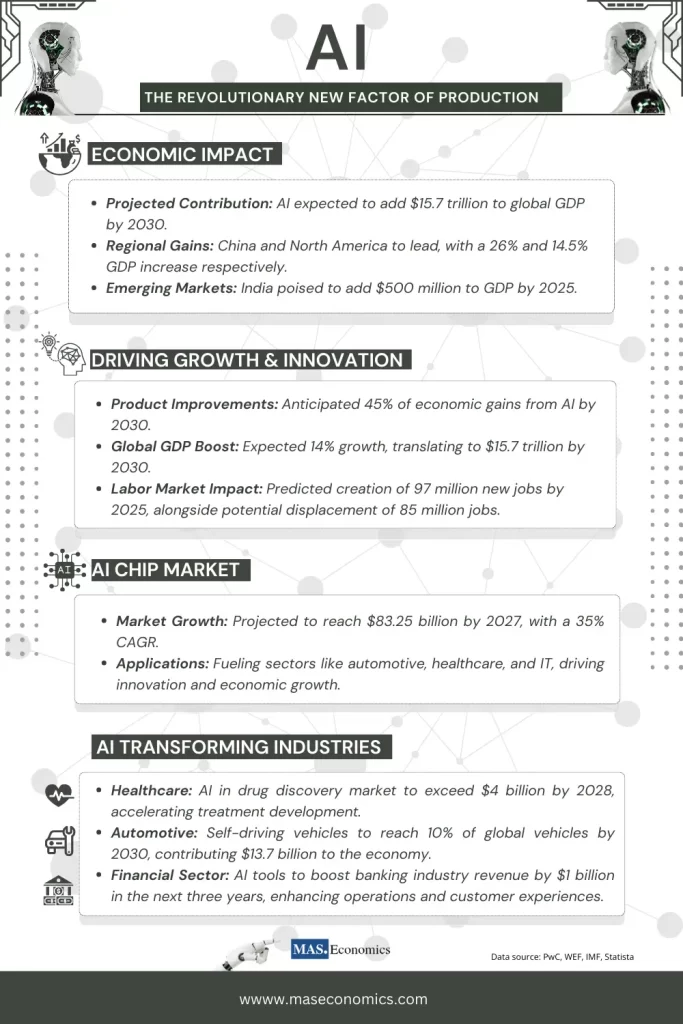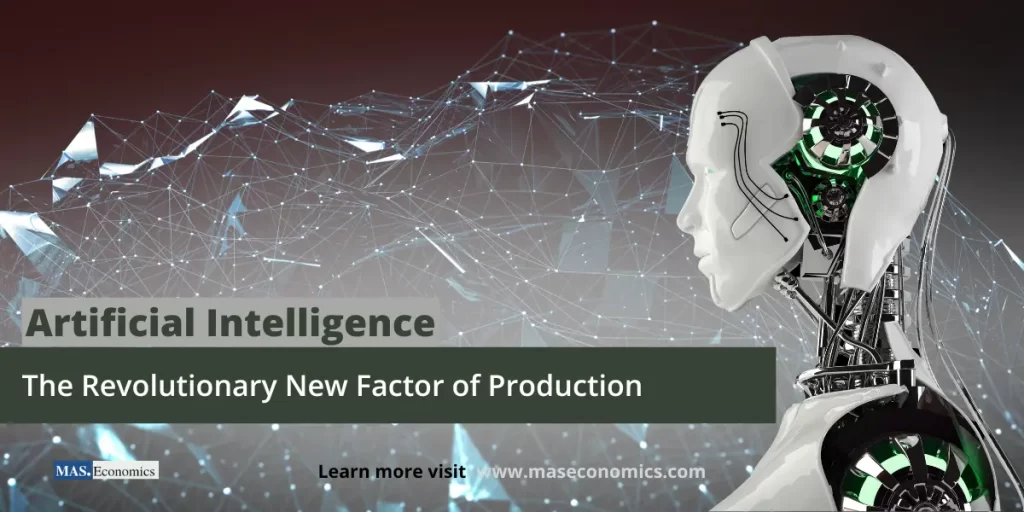Artificial Intelligence (AI) rapidly emerges as a transformative force, reshaping industries and economies globally. This disruptive technology is automating tasks, augmenting human capabilities, and unveiling new frontiers of innovation and productivity. As AI continues to permeate various sectors, it is increasingly being recognized as a critical and revolutionary new factor of production, poised to drive economic growth and redefine the contours of the global outlook.
The traditional factors of production – land, labor, and capital – have historically been the driving forces behind economic growth. Land, encompassing natural resources, has provided the raw materials for production; labor, human effort, and skills; and capital, the necessary tools, machinery, and infrastructure. However, the advent of AI challenges this long-standing paradigm, introducing a new factor with unique capabilities and potential.

AI as a New Factor of Production
Unlike traditional factors such as land and capital, AI is intangible yet infinitely scalable. It doesn’t deplete over time and, importantly, can improve and evolve on its own. AI blurs the line between a productive resource and an active participant in the production process, making it an integral driver of both efficiency and innovation.
AI’s ability to process vast amounts of data, learn from it, and make autonomous decisions sets it apart from conventional factors. While labor is limited by physical and mental capabilities and capital by wear and tear, AI has no such constraints. AI can work around the clock, self-optimize, and improve with each iteration, making it a constantly evolving factor of production.
Comparison to Traditional Factors of Production
Unlike labor, AI operates without physical exhaustion and continuously improves through machine learning. Capital, in the form of machinery, wears out over time, but AI only gets better as algorithms evolve. For example, where a worker’s productivity is tied to physical hours worked, AI systems can enhance productivity 24/7 by automating repetitive tasks, conducting complex analyses, and generating insights, increasing overall productivity without requiring downtime.
This scalability and continuous self-improvement mean that AI is not just an additional input in the production function but one that can transform entire industries.
Economic Impact of AI as a Factor of Production
According to estimates by PricewaterhouseCoopers (PwC), AI is expected to contribute a staggering $15.7 trillion to the global economy by 2030, surpassing the current combined output of China and India. This economic significance is a testament to AI’s transformative power as a factor of production.
Unlike traditional factors, AI is not a finite resource; it can be continuously improved, replicated, and scaled, transcending geographical and physical limitations. AI’s ability to learn, adapt, and evolve sets it apart from conventional tools and machinery, enhancing its role in economic output.
AI Driving Economic Growth and Innovation
Beyond its direct contributions to GDP, AI also drives economic growth and fosters innovation through diverse channels. By 2030, an estimated 45% of the economic gains attributed to AI will stem from product improvements. AI’s ability to analyze vast amounts of data, identify patterns, and generate insights enables companies to develop new products, optimize existing offerings, and enhance customer experiences.
Practical Example:
Think of AI in e-commerce. Amazon uses AI to streamline its supply chain, forecast demand, and personalize shopping experiences. This results in lower operational costs, higher sales, and improved customer satisfaction—all thanks to AI’s contribution as a “labor force” working 24/7 to improve operational efficiency.
Similarly, AI’s role in sectors like healthcare, finance, and automotive industries is driving innovation and improving services, illustrating AI’s flexibility and adaptability across various sectors.
Job Creation and Labor Market Disruption
AI’s impact on the labor market is an ongoing debate, with experts weighing the potential for job creation against the risk of job displacement. The World Economic Forum (WEF) has predicted that by 2025, AI could create 97 million new jobs across 26 countries. However, it could also potentially displace around 85 million jobs, which makes it crucial to take proactive measures to reskill and upskill workers.
The creation of new roles such as AI trainers, data scientists, and AI ethics consultants highlights the shift in labor demands. Workers will need new skill sets to remain competitive in a job market that increasingly relies on advanced technology.
AI Augmenting Human Labor: Increasing Productivity
Accenture estimates that AI-based technologies may increase labor productivity by up to 40% across 16 industries by 2035. This underscores AI’s potential to augment human capabilities, streamline processes, and drive efficiency. Rather than replacing human labor entirely, AI can take over mundane, repetitive tasks, freeing up human workers to focus on higher-value tasks that require creativity, judgment, and emotional intelligence.
AI Transforming Production Methods and Industries
AI’s unique capabilities as a factor of production are evident in its ability to foster entirely new industries and production methods. Take, for example, the field of generative AI, which includes technologies like ChatGPT. This AI application is revolutionizing industries like content creation, design, and problem-solving by automating complex tasks traditionally done by humans.
In manufacturing, AI integration is transforming production lines into smart factories, where robots powered by AI work alongside humans to produce goods faster and more accurately. Generative design is another field where AI is reshaping production by generating product designs optimized for cost, strength, and material use.
Example: AI in Self-Driving Vehicles
AI’s role in the automotive industry, particularly in self-driving cars, offers a glimpse of the future of production. Autonomous vehicles rely on advanced AI to navigate roads, predict traffic patterns, and make real-time decisions. Statista estimates that by 2030, one in ten cars globally will be self-driving, contributing $13.7 billion to the economy. AI’s ability to process real-time data and make autonomous decisions highlights its revolutionary role in shaping the future of mobility and logistics.
Example: AI in the Financial Sector
AI is also making its mark in the financial services industry, where its ability to streamline operations, improve decision-making, and enhance customer experiences is proving transformative. Accenture predicts that AI tools will boost banking industry revenue by $1 billion within the next three years. The financial sector is increasingly adopting AI to automate risk assessments, manage fraud detection, and optimize trading strategies, all of which are contributing to growth and innovation in the industry.
AI’s Role in Fostering New Markets
The burgeoning AI chip market indicates AI’s growing economic significance. The global AI chip market is projected to reach $83.25 billion by 2027, according to Insight Partners. AI-specific hardware is needed to power the sophisticated computations AI models require, further underscoring AI’s dual role as both a tool and an enabler of new industries.
AI and Capital Efficiency
While capital has traditionally been essential for acquiring tools, machinery, and infrastructure, AI offers a new form of capital that enhances resource use. Companies leveraging AI find themselves more capital-efficient by optimizing operations, reducing waste, and unlocking new revenue streams. For example, the financial sector is experiencing significant benefits from AI’s ability to streamline operations, improve decision-making, and enhance customer experiences.
Exchange Between Industries and AI-Driven Innovation
AI’s economic influence is evident across diverse sectors. In healthcare, AI streamlines diagnostics, accelerates drug discovery and improves patient outcomes by analyzing complex medical data. In financial services, AI enhances predictive analysis, fraud detection, and personalized customer interactions. In transportation, self-driving technology revolutionizes mobility solutions, while in manufacturing, AI optimizes production cycles and reduces downtime.
Conclusion
In conclusion, AI represents a revolutionary new factor of production, poised to reshape industries and redefine economic paradigms. It complements and augments traditional factors of production, offering scalability, adaptability, and unparalleled potential for innovation. The rise of AI will continue to drive economic growth across industries by increasing productivity, creating new jobs, and enhancing human capabilities. However, addressing challenges like job displacement, reskilling, and ethical concerns will be critical for inclusive and sustainable growth.
By proactively embracing AI’s potential and addressing its challenges, nations, and industries can unlock unprecedented productivity, prosperity, and innovation—ensuring that AI’s benefits are distributed equitably across the global economy.
Thanks for reading! If you found this helpful, share it with friends and spread the knowledge.
Happy learning with MASEconomics




